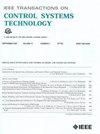Passivity-Based Control Approach for Photovoltaic DC-DC Conversion and Output Voltage Regulation
IF 3.9
2区 计算机科学
Q1 AUTOMATION & CONTROL SYSTEMS
引用次数: 0
Abstract
This article introduces a novel control approach for tackling the maximum power point tracking (MPPT) and output voltage regulation (VR) in photovoltaic (PV) cell systems. Leveraging the port-Hamiltonian (pH) formalism, an energy-based framework known for its physically multidomain modeling and control methodologies, our proposed control law offers promising solutions. Our control design is rooted in an interconnection damping assignment passivity-based strategy, incorporating temperature dependencies of the internal PV cell parameters. To validate the efficacy of our approach, we modeled, implemented, and calibrated a prototype system comprising a PV cell, a dc–dc buck converter, and a dc–dc boost converter that feeds a battery load. The entire setup is designed within the pH framework, ensuring a cohesive integration of energy-based control. To highlight our energy-based strategy’s reliability and performance, we evaluated it against a commercial solar charger under real solar irradiance conditions. Our experimental findings unequivocally demonstrate that the control mechanism employed by the commercial solar charger demands a significantly higher amount of energy and exhibits a premature collapse at lower power levels when compared to our proposed system and control strategy.基于无源性的光伏DC-DC转换及输出电压调节控制方法
本文介绍了一种解决光伏电池系统中最大功率点跟踪(MPPT)和输出电压调节(VR)的新型控制方法。利用port- hamilton (pH)形式化,一种以物理多域建模和控制方法而闻名的基于能量的框架,我们提出的控制律提供了有希望的解决方案。我们的控制设计植根于基于互连阻尼分配的无源性策略,结合了PV电池内部参数的温度依赖性。为了验证我们方法的有效性,我们对一个原型系统进行了建模、实现和校准,该原型系统包括一个光伏电池、一个dc-dc降压转换器和一个dc-dc升压转换器,为电池负载提供电源。整个设置是在pH框架内设计的,确保了基于能量控制的内聚集成。为了突出我们基于能源的策略的可靠性和性能,我们在实际太阳辐照度条件下对商用太阳能充电器进行了评估。我们的实验结果明确表明,与我们提出的系统和控制策略相比,商用太阳能充电器采用的控制机制需要大量的能量,并且在较低功率水平下表现出过早崩溃。
本文章由计算机程序翻译,如有差异,请以英文原文为准。
求助全文
约1分钟内获得全文
求助全文
来源期刊

IEEE Transactions on Control Systems Technology
工程技术-工程:电子与电气
CiteScore
10.70
自引率
2.10%
发文量
218
审稿时长
6.7 months
期刊介绍:
The IEEE Transactions on Control Systems Technology publishes high quality technical papers on technological advances in control engineering. The word technology is from the Greek technologia. The modern meaning is a scientific method to achieve a practical purpose. Control Systems Technology includes all aspects of control engineering needed to implement practical control systems, from analysis and design, through simulation and hardware. A primary purpose of the IEEE Transactions on Control Systems Technology is to have an archival publication which will bridge the gap between theory and practice. Papers are published in the IEEE Transactions on Control System Technology which disclose significant new knowledge, exploratory developments, or practical applications in all aspects of technology needed to implement control systems, from analysis and design through simulation, and hardware.
 求助内容:
求助内容: 应助结果提醒方式:
应助结果提醒方式:


